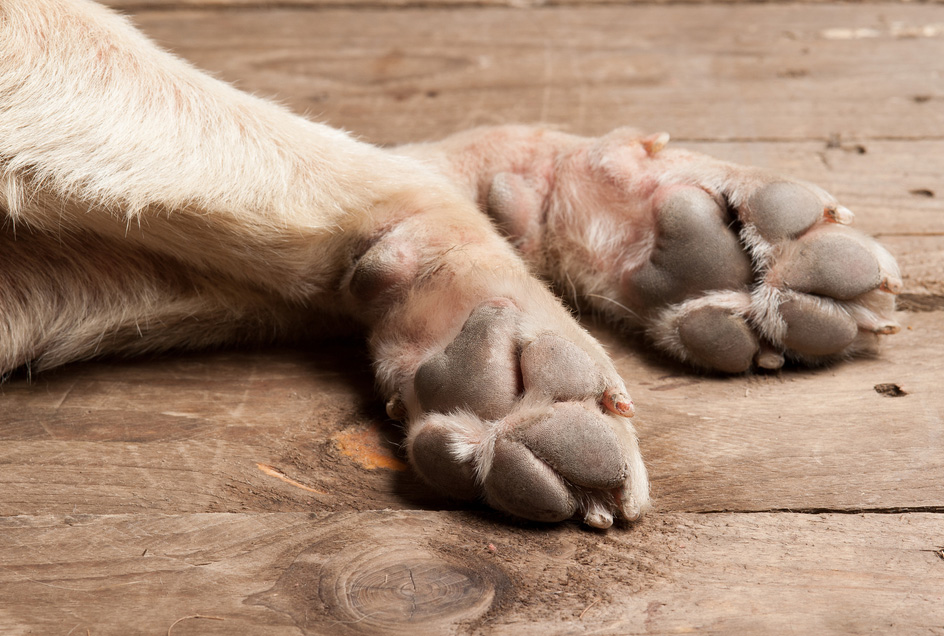Common Reasons for Paw Licking in Dogs
One of the common issues we are asked about is “why does my dog keep licking his paw?” Dog’s paws are built to handle considerable stress but constant licking is often a sign that something is amiss and should be discussed with your vet.
1. Fungal Infections: Yeast organisms (fungi) are normally found on your dog’s paws, but an underlying condition can cause them to multiply and cause problems. Yeast infections are often secondary to allergy, the doctors say, with the most likely culprit atopic dermatitis. However, environmental or food allergies also could be to blame.
Your vet can test the area to determine if yeast is the culprit and treat the infection with topical products, antifungal wipes and shampoos. If these treatments don’t do the trick, the underlying allergy may need to be addressed with antihistamines, steroids or anti-itch medications.
2. Bacterial Infections: Bacterial organisms also are normally found on your dog’s paws, but a secondary health condition can cause them to multiply excessively. Symptoms include licking/biting, redness, swelling, pain/itching and abscess. Your vet can take a sample tissue from the affected area and evaluate it to determine if bacteria are the problem and, if so, prescribe either oral or topical antibiotics and antibacterial shampoos and soaks.
3. Burns: Hot asphalt can hurt your dog’s paws, and burns need to be treated immediately. Bandaging usually is required as a protective barrier on the skin or paw pad affected, Levitzke says. Antibiotics and pain medication are also typically indicated.
4. Frostbite: As with burns from hot asphalt or pavement, these injuries need immediate veterinary attention. Treatment for frostbite includes bandaging, pain control and anti-infection measures. Avoid this injury by limiting your dog’s exposure to the elements.
5. Ingrown Toenails: Nails that are not trimmed properly or naturally worn down by walking outside can become painful ingrown toenails. Your vet can treat them with antibiotics and pain medication, but severely ingrown nails might have to be surgically removed.
6. Torn Toenails: A torn nail is common in the emergency room, often after a tussle with another dog or a paw snags on carpeting or other material. When the entire nail has been pulled off, take your dog to the vet for immediate treatment to stop bleeding and manage pain. Antibiotics also might be prescribed.
7. Winter Salt: Prevention is the best way to avoid these injuries. Put booties on your dog’s feet and use dog-safe salt. If your dog does get salt on his paws, wipe it off with a towel/paper towels or rinse with warm water and dry thoroughly.
8. Ticks: One of the more common places ticks hide is the toes. It is best to have a veterinary medical professional remove the tick. Never take a lit or recently lit match to the tick. If you can’t get to the vet, use tweezers to grip the tick from the head and gently pull it out. The head must become detached along with the body for successful removal. Pet supply stores also sell special tick-removal tools.
9. Mites: Mites such as Demodex canis can present a frustrating problem and require a deep skin scrape or a biopsy to diagnose. These mites can cause Demodicosis in which the mites that normally live in your dog’s hair follicles multiply and cause swelling, hair loss and scaling on your dog’s paws. Your vet will examine hair or skin samples under a microscope to accurately diagnose the condition, which is treated with medication, sometimes for several months.
10. Excessive Hair: Dogs with lots of hair on their feet can catch gum, sticky asphalt, burrs and thorns in crevices, which can be hard to find and painful to remove. Prevent these problems by having the hair clipped by your groomer. Ingrown hairs manifest in short-haired dogs as tiny pimples and can lead to furunculosis, an infection deep in the hair follicle that can abscess and cause tissue damage.
[source: PetMD]

